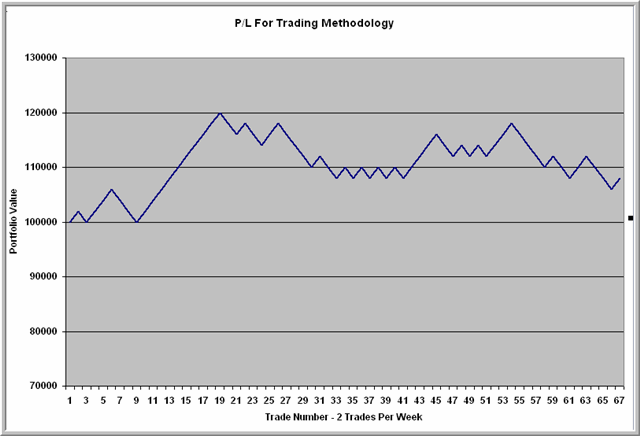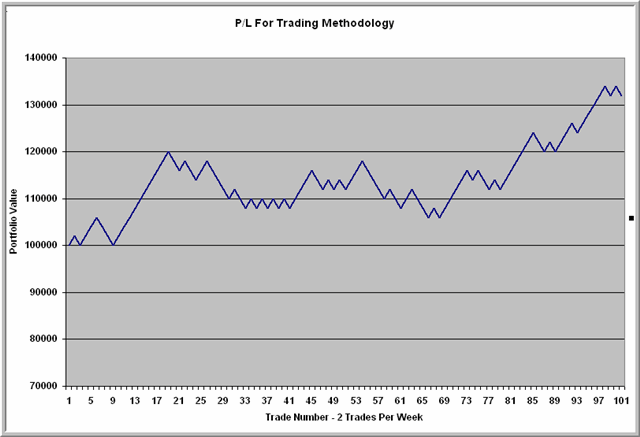How to manage the psychological risks of trading
In our article earlier this week, we made the distinction between trading to not lose vs. trading to win. We suggested that trading to not lose occurs when
perceived risk varies greatly from actual risk. Under those conditions, we will fail to take advantage of genuine opportunities (if we perceive risk as
greater than it really is) or we will lurch into markets when there is no opportunity (if we perceive less risk than is truly present).
Suppose we offer you a trading methodology that is 60% accurate across a variety of trading conditions over a period of many years. All you have to
do is risk a prudent 2% of your capital on each trade and ride your edge. The method trades twice a week and, on a historical basis, has been solidly
profitable every year for the past five years.
After performing your due diligence, you decide to follow the trading method. You begin with $100,000 of capital. To see what your results might look like in a year’s time, Dr. Brett employed a random number generator that spit out numbers between 1 and 50. If the number came out to be 1-20, the trade was considered a loser and $2000 was deducted from the account. If the number was higher than 20, the trade was deemed a winner and $2000 was added to the account. That provided a random sequence of winners and losers with an overall 60/40 win/loss edge and risk per trade limited to 2% of starting capital. (Note: This is a simplified example. Commissions and other trading expenses were not deducted; in real life we would risk X% of portfolio value, not a fixed percentage of starting capital).
By August, here is what your trading results looked like:

The good news is that you’re up money. Indeed, you’ve made
8% on your initial capital. Not sexy, perhaps, but better than the
proverbial stick in the eye. The bad news is that, since March, you’re
actually down money. In fact, for most of the year so far you’ve been
treading water. Notice that, even with this built-in edge and prudent
loss limits, there are psychological risks embedded in trading:
-
The risk of boredom – Many traders are
attracted to trading because of the possibility of large P/L moves in a
relatively short period of time. Our sound trading method offers
little such excitement. Indeed, there are long periods of relatively
flat performance. If the trader is trading for needs other than
profitability (excitement, quick riches), he or she is apt to abandon the
method after months of treading water.
-
The risk of drawdown – Many traders equate a
trading edge with a smooth equity curve. Not so! As we mentioned
in the earlier article, even a method with a 60/40 win/loss ratio will
experience a series of four losing trades 2-3 times on average per 100
trades. In the case of our random order of wins and losses, we wound
up with months of drawdown, albeit modest. The trader who equates
drawdown with failure will abandon even a good method.
-
The risk of drawup – We made up that term, in
case you wondered, but you get the point. If drawdown is the amount
your portfolio loses value in a period of time, drawup is the amount your
portfolio rises. In a relatively short period, we had a series of
winners early in the year, putting the portfolio up 20%. A method with
60% winners has about a 13% chance of giving you streaks of four consecutive
wins. Why is this a risk? After a big drawup, many traders
become overconfident and change their position sizing and trading frequency,
negating their edge. Their expectations raised, they find it harder to
get through the inevitable periods of flat performance.
So let’s say you succumb to those risks and, by August, abandon
the trading method. Here’s how our random sequencing of winners and losers
wound up the year:

Silly us. Just as we bailed out due to boredom, drawdown,
and/or unfulfilled high expectations, the method gave us a streak of winning
trades. By the end of the year, we would have been up over 30% on our
initial capital.
This raises the most fundamental psychological risk of all:
-
The risk of sequencing – Quite simply, even
with a demonstrated edge and prudent loss limits, we cannot know in advance
the sequencing of our winners and losers. The account is up handsomely
for the year, but spent just as much time treading water as rising.
Much of the method’s gains were obtained in a relatively short period of
time–but we can’t know what that precise time is going to be.
That means we have to endure down sequences and flat ones in order to get to
the winning periods.
The risk of sequencing is a psychological risk even if you have
an edge, and it is a risk whether you trade a mechanical system or in a totally
discretionary manner. Quite simply, if you have X% odds of winning, you
can determine the probability of encountering streaks of wins and losses.
If you perceive those streaks as abnormal events–even when they’re
statistically expectable–you will respond to them abnormally: with anxiety,
self-doubt, and likely missed opportunity.
Sequencing offers psychological risk because we tend to
take those sequences personally. When we have a string of wins, we
think we have a hot hand. We think we’ve figured the market out. We
feel overconfident, and we act accordingly. Conversely, when we have a
string of losses, we think we’re on a cold streak. We think we’ve lost our
edge. We lose confidence, and we act accordingly. And if we have
strings of alternating wins and losses? We think we’re wasting our time,
going nowhere. We feel bored, and we act accordingly.
The best psychological treatment aligns psychological
risk–the risk we perceive–with actual market risk. We accomplish
that by knowing–as precisely as possible–the historical performance of our
trading methods. That is relatively easy when we’re trading mechanical
systems: many software programs will provide us with detailed reports of system
performance, including drawdowns, the maximum number of successive winners and
losers, and P/L curves.
What many traders don’t know is that, they can obtain similar
reports for their discretionary trading. Programs such as Trader DNA (www.traderdna.com
) and platforms such as Neoticker (www.tickquest.com)
and Ninja Trader (www.ninjatrader.com)
collate trading results for traders and calculate performance statistics,
similar to those used to evaluate trading systems. These statistics can be
collected for simulated as well as live trading, enabling traders to determine
their edges before placing money at risk. (Disclaimer: We have no
commercial ties to any of these firms or services).
The psychologist Donald Meichenbaum introduced a technique for
stress management that he called stress inoculation. He found that
exposing people to low levels of an anticipated stressor helped them cope with
actual stresses when they occurred. Evaluating your performance–knowing
your likely drawdowns, drawups, and flat performances in advance–is a kind of
stress inoculation, preparing you for the outcomes you’re likely to face even
when you trade well. We are well acquainted with how emotions can
disrupt trading; less well appreciated is how trading can play with our
heads! As in medicine, a little inoculation can go a long way toward
preventing major ills.
Brett N. Steenbarger, Ph.D. is
Associate Clinical Professor of Psychiatry and Behavioral Sciences at SUNY
Upstate Medical University in Syracuse, NY and author of The
Psychology of Trading (Wiley, 2003). As Director of Trader Development
for Kingstree Trading, LLC in Chicago, he has mentored numerous professional
traders and coordinated a training program for traders. An active trader of the
stock indexes, Brett utilizes statistically-based pattern recognition for
intraday trading. Brett does not offer commercial services to traders, but
maintains an archive of articles and a trading blog at www.brettsteenbarger.com
and a blog of market analytics at www.traderfeed.blogspot.com.
His book, Enhancing Trader Development, is due for publication this fall
(Wiley).
Adam Mann is a technical writer with Wildwood Partners, LLC, an Arizona-based firm that researches and develops trading strategies across multiple markets. Over the course of eight years, Wildwood Partners has developed its own proprietary model that has demonstrated above average performance while trading a real time virtual account. It combines pattern recognition with breakout and trend following concepts.
